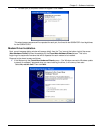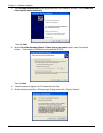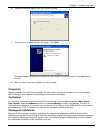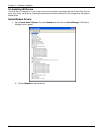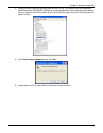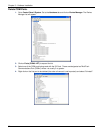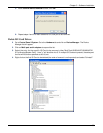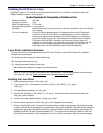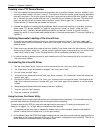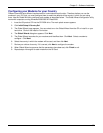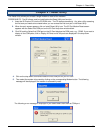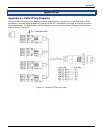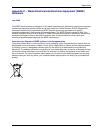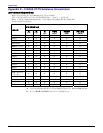
Chapter 3 – Software Installation
36
Creating Linux TTY Device Names
1. This driver retains the standard serial device properties: dial-in port files (named in the form "ttyMUxy"), and
call-out port files (named in the form "cumxy"). File names of these two special types become associated
with each serial port. The first file type is for the dial-in port and has a name of the form "ttyMUxy" where
the "x" denotes the card number and the final "y" denotes the port number on that card. The second file
type is for the call-out port and has a name of the form "cumxy" where, again, the "x" denotes the card
number and the "y" denotes the port number on that card.
2. Consider the situation of installing two 8-port Modem Cards in the server computer. In that case, the driver
would create TTY devices "ttyMUla" to "ttyMUlh" and devices "cumla" to "cumlh" under the "/dev"
directory for card 1. Similarly, devices ttyMU2a to ttyMU2h and devices "cum2a" to "cum2h" would be
created for card 2. (If a 4-port card were installed as card 1, the driver would create TTY devices "ttyMUla" to
"ttyMUld.")
Verifying Successful Loading of the Linux Driver
1. To confirm the successful loading of the driver, execute the command "lsmod". The driver "mtsi_upci"
should be listed in the list of modules. If the driver is not listed, invoke the "lsmod" command again and
watch for errors.
2. Check that the tty devices (with names of the form "ttyMUxy") are listed under the /dev directory. If the tty
devices are not listed, invoke the ". /mknod_script" command again (it was previously run as part of the
"make install" script in step 7 of the "Building the Linux Driver" procedure) and watch for errors.
3. To confirm that the tty devices function for each modem on the ISI Card, execute the utility "minicom" and
dial out on each modem.
Un-Installing the Linux ISI Driver
1. Run the "make clean" script. You must run this command from the "mtsi_upci_driver" directory.
2. The "make clean" script will delete the "resetport" and "mtsi_upci.o" files.
3. Run the "make uninstall" script.
4. You must run this command from the "mtsi_upci_driver" directory. The "make clean" script will remove the
module "mtsi_upci".
5. Execute the "lsmod" command. The "mtsi_upci" module should no longer be listed. If this module is still
listed, then invoke the command "rmmod mtsi_upci" and check again to see whether or not the module
is listed.
6. Delete serial ports (these are files with names of the form "ttyMUxy").
7. To do so, go to the "dev" directory.
8. Enter the command "rm ttyMUZ".
Using the Linux Port Reset Utility
For the Modem Cards, the port-reset utility allows you to reset ports without rebooting. For the modem cards, the
port-reset utility allows you to reset both ports and modems without rebooting.
To reset a serial port, the DTR pin is set to the low logic level for one second. To reset the modem port, the
Reset pin is toggled (i.e., its logic state is inverted and then restored).
1. To reset the port (for serial card) or modem (for modem card) run the command "resetport /dev/ttyMUxy"
(where 'x' stands for card number and 'y' for the port number).
2. On the Modem Cards, the DTRLED will toggle indicating that the reset has occurred and this toggling might be
observable on the modem attached to the port (if the modem is equipped for this indication). There is no
similar indication of successful reset on the modem cards.



